The Importance of Checking Indoor Air Quality in Underground Historic Buildings Intended for Tourist Use
Abstract
:1. Introduction
1.1. Historical Heritage of the Spanish Civil War in Alicante
1.2. The Shelter of Seneca Square Construction and Restoration
1.3. Radon Gas in Alicante
1.4. Importance of Radon Gas Measurement in Heritage Buildings Intended for Tourist Use
2. Methodology for Measuring Radon Gas in the Shelter
3. Results Analysis
4. Conclusions
Author Contributions
Funding
Acknowledgments
Conflicts of Interest
References
- López, M.M. La Experiencia Republicana y la Guerra Civil en Alicante; Editor Club Universitario: Alicante, Spain, 2007; p. 211. [Google Scholar]
- Serrano, E.G. Diarios de la Guerra Civil (1936–1939); Editor Fondo Archivo de la Democracia, Universidad de Alicante: Alicante, Spain, 2008; p. 716. [Google Scholar]
- Wyden, P. La Guerra Apasionada: Historia Narrativa de la Guerra Civil Española, 1936–1939; Roca, M., Ed.; Martínez Roca: Alicante, Spain, 1983; p. 536. [Google Scholar]
- Molina, C. Los Refugios en Alcoy; Eines, Q., Ed.; Universidad De La Rioja: La Rioja, Spain, 1990; p. 111. [Google Scholar]
- Gil, C.G. La Plaza de Balmis Como Metáfora de Alicante. 2014. Available online: https://carlosgomezgil.com/2014/04/06/la-plaza-de-balmis-como-metafora-de-alicante/ (accessed on 23 January 2019).
- Fondos, A.M.A. Archivo Municipal de Alicante; Ayuntamiento de Alicante: Alicante, Spain, 2015. [Google Scholar]
- Olivares, F.L.; Voigt, M.L. Refugios Antiaéreos de la Guerra Civil en Alicante: Intervenciones Arqueológicas en las Plazas de Séneca y Dr. Balmis. In Revista Lvcentvm; Lvcentvm-Universidad de Alicante: Alicante, Spain, 2015; pp. 363–400. [Google Scholar]
- Quiertant, P.S.; García, R.M. Refugios antibombardeo dela Guerra Civil Española en el Valle de Henares. In Proceedings of the Actas XII Encuentro de Historiadores del valle del Henares, Alcala De Henares, Spain, 25–28 November 2010. [Google Scholar]
- Castro, V.L.A.; Cerruto, A.F.M.; Chambi, L.; Perez, F. Botellas pet en el Hormigón ciclópeo de los cimientos corridos para la construcción de viviendas. Rev. Investig. y Desarro. 2011, 6, 43. [Google Scholar]
- Centro de Interpretación. Ayuntamiento de Alicante; Refugios Antiaéreos de Alicante: Alicante, Spain, 2015. [Google Scholar]
- Concejalía de Cultura Ayuntamiento de Alicante. Restauración de Los Murales de Gastón Castelló; Concejalía de Cultura Ayuntamiento de Alicante: Alicante, Spain, 2014. [Google Scholar]
- De Profit Alacantí. La Nueva Plaza Séneca. 2014. Available online: http://alacantideprofit.blogspot.com/2014/09/la-nueva-plaza-seneca-1-derribos-y.html (accessed on 23 January 2019).
- Cuvier, A.; Panza, F.; Pourcelot, L.; Foissard, B.; Cagnat, X.; Prunier, J.; van Beek, P.; Souhaut, M.; Roux, G.L. Uranium decay daughters from isolated mines: Accumulation and sources. J. Environ. Radioact. 2015, 149, 110–120. [Google Scholar] [CrossRef] [PubMed]
- Szabó, K.Z.; Jordan, G.; Horváth, Á.; Szabó, C. Mapping the geogenic radon potential: Methodology and spatial analysis for central Hungary. J. Environ. Radioact. 2014, 129, 107–120. [Google Scholar]
- Collignan, B.; Powaga, E. Impact of ventilation systems and energy savings in a building on the mechanisms governing the indoor radon activity concentration. J. Environ. Radioact. 2019, 196, 268–273. [Google Scholar] [CrossRef] [PubMed]
- Valkovic, V. Radioactivity in the Environment. Radioact. Environ. 2009, 15, ii. [Google Scholar]
- NSC United. On the Effects of Atomic Radiation. In Sources and Effects of Ionizing Radiation: United Nations Scientific Committee on the Effects of Atomic Radiation: UNSCEAR 2000 Report to the General Assembly, with Scientific Annexes; United Nations: New York, NY, USA, 2000. [Google Scholar]
- Cristobo, J.J.J.L. Medición De La Concentración De Gas 222Rn en El Interior De Edificios; USC. Departamento de Física de las Partículas: A Coruña, Spain, 2006; p. 64. [Google Scholar]
- Boerma, M.; Sridharan, V.; Mao, X.W.; Nelson, G.A.; Cheema, A.K.; Koturbash, I.; Singh, S.P.; Tackett, A.J.; Hauer-Jensen, M. Effects of ionizing radiation on the heart. Mutat. Res./Rev. Mutat. Res. 2016, 770, 319–327. [Google Scholar] [CrossRef] [Green Version]
- Ravanat, J.L.; Douki, T. UV and ionizing radiations induced DNA damage, differences and similarities. Radiat. Phys. Chem. 2016, 128, 92–102. [Google Scholar] [CrossRef]
- Amber, I.; O’Donovan, T.S. Natural convection induced by the absorption of solar radiation: A review. Renew. Sustain. Energy Rev. 2018, 82, 3526–3545. [Google Scholar] [CrossRef]
- Rizo Maestre, C.; Chinchón Yepes, S. Radon Gas. Hazardous element for human life really found in the environment. In Proceedings of the 2nd International Conference on Green Materials and Environmental Engineering, Phuket, Thailand, 20–21 December 2015; pp. 60–62. [Google Scholar]
- Consejo de Seguridad Nuclear. Dosis de Radiación; Consejo de Seguridad Nuclear: Madrid, Spain, 2010; p. 18. [Google Scholar]
- Barbosa-Lorenzo, R.; Ruano-Ravina, A.; Caramés, S.C.; Barros-Dios, J.M. Radón residencial y cáncer de pulmón. Un estudio ecológico en Galicia. Med. Clin. 2015, 144, 304–308. [Google Scholar] [CrossRef]
- Nastro, V.; Carnì, D.L.; Vitale, A.; Lamonaca, F.; Vasile, M. Passive and active methods for Radon pollution measurements in historical heritage buildings. Measurement 2018, 114, 526–533. [Google Scholar] [CrossRef]
- Li, P.; Zhang, R.; Gu, M.; Zheng, G. Uptake of the natural radioactive gas radon by an epiphytic plant. Sci. Total Environ. 2018, 612, 436–441. [Google Scholar] [CrossRef] [PubMed]
- Zeeb, H. International Radon Project. Survey On Radon Guidelines, Programmes and Activities; WHO HSE/PHE/RAD: Geneva, Switzerland, 2007; p. 49. Available online: https://www.who.int/ionizing_radiation/env/radon/IRP_Survey_on_Radon.pdf (accessed on 23 January 2019).
- Cannistraro, M.; Lorenzini, E. The Applications of the New Technologies “E-Sensing” in Hospitals. Int. J. Heat Technol. 2016, 34, 551–557. [Google Scholar] [CrossRef]
- 440NTP. Radón en Ambientes Interiores. 1999. Available online: http://www.insht.es/InshtWeb/Contenidos/Documentacion/FichasTecnicas/NTP/Ficheros/401a500/ntp_440.pdf (accessed on 23 January 2019).
- Amgarou, K. Long-Term Measurements of Indoor Radon and Its Progeny in The Presence of Thoron Using Nuclear Track Detectors a Novel Approach; Universitat Autònoma de Barcelona: Bellaterra, Spain, 2003. [Google Scholar]
- Cambeses, A.; Garcia-Casco, A.; Scarrow, J.H.; Montero, P.; Pérez-Valera, L.A.; Bea, F. Mineralogical evidence for lamproite magma mixing and storage at mantle depths: Socovos fault lamproites, SE Spain. Lithos 2016, 266–267, 182–201. [Google Scholar] [CrossRef]
- Duval, J.S. Use of Aerial Gamma-Ray Data to Estimate Relative Amounts of Radon in Soil Gas. In Field Studies of Radon in Rocks, Soils and Water; Gundersen, L.C.S., Wanty, R.B., Eds.; Geological Survey: Alexandria, VA, USA, 1991. [Google Scholar]
- Tanner, A.B. Methods of Characterization of Ground for Assessment of Indoor Radon Potential at a Site. In Field Studies of Radon in Rocks, Soils and Water; Gundersen, L.C.S., Wanty, R.B., Eds.; Geological Survey: Alexandria, VA, USA, 1991. [Google Scholar]
- Ielsch, G.; Cushing, M.E.; Combes, P.; Cuney, M. Mapping of the geogenic radon potential in France to improve radon risk management: methodology and first application to region Bourgogne. J. Environ. Radioact. 2010, 101, 813–20. [Google Scholar] [CrossRef] [PubMed]
- Kemski, J.; Siehl, A.; Stegemann, R.; Valdivia-Manchego, M. Mapping the geogenic radon potential in Germany. Sci. Total Environ. 2001, 272, 217–30. [Google Scholar] [CrossRef]
- Neznal, M.; Matolín, M.; Barnet, I.; Mikšová, J. The New Method for Assessing the Radon Risk of Building Sites; Czech Geological Survey: Praha, Czech, 2004; pp. 7–47. [Google Scholar]
- Mahou, E.S.; Ángel Fernández Amigot, J.; Espasa, A.B.; Bonito, M.C.M.; del Pozo, J.M.; del Busto, J.M.L. Proyecto Marna (Mapa de Radiación Gamma Natural en España); Consejo de Seguridad Nuclear: Madrid, Spain, 2000; p. 87. [Google Scholar]
- Olaya, M.; Borja, F. El Código Técnico de la Edificación en España (CTE) Medidas Correctoras Destinadas a Frenar La Entrada de Radón en los Edificios. Investigación de Campo Como Experiencia Piloto en España, 2007. Available online: https://docplayer.es/22067449-El-codigo-tecnico-de-la-edificacion-en-espana-cte-medidas-correctoras-destinadas-a-frenar-la-entrada-de-radon-en-los-edificios.html (accessed on 23 January 2019).
- Cepedal, A.; Fuertes-Fuente, M.; Martín-Izard, A.; García-Nieto, J.; Boiron, M.C. An intrusion-related gold deposit (IRGD) in the NW of Spain, the Linares deposit: Igneous rocks, veins and related alterations, ore features and fluids involved. J. Geochem. Explor. 2013, 124, 101–126. [Google Scholar] [CrossRef]
- Rizo Maestre, C.; Echarri Iribarren, V. The Radon Gas in Underground Buildings in Clay Soils. The Plaza Balmis Shelter as a Paradigm. Int. J. Environ. Res. Public Health 2018, 15, 1004. [Google Scholar] [CrossRef]
- Rizo Maestre, C.; Chinchón Yepes, S. Detection and importance of the presence of Radon Gas in buildings. Int. J. Eng. Tech. Res. 2016, 4, 67–70. [Google Scholar]
- United States Environmental Protection Agency. Health Risk of Radon; United States Environmental Protection Agency: Washington, DC, USA.
- Tchorz-Trzeciakiewicz, D.E.; Parkitny, T. Radon as a tracer of daily, seasonal and spatial air movements in the Underground Tourist Route “Coal Mine” (SW Poland). J. Environ. Radioact. 2015, 149, 90–98. [Google Scholar] [CrossRef]
- Scheib, C.; Appleton, J.D.; Miles, J.C.H.; Hodgkinson, E. Geological controls on radon potential in England. Proc. Geol. Assoc. 2013, 124, 910–928. [Google Scholar] [CrossRef] [Green Version]
- Field, R.W. Radon: An Overview of Health Effects; Elsevier: New York, NY, USA, 2011. [Google Scholar]
- García, B.P.; Payá, S.C.; Recio, M.A.M.; Barbudo, M.A.S. Radiactividad natural de los materiales de construcción. Aplicación al hormigón. Parte II. Radiación interna: el gas radón; Revista Técnica Cemento Hormigón; RUA: Alicante, Spain, 2011; pp. 34–50. [Google Scholar]
- Cannistraro, M.; Galvagno, A. Analysis of Air Pollution in the Urban Center of Four Cities Sicilian. Int. J. Heat Technol. 2016, 34, S219–S225. [Google Scholar] [CrossRef]
- Cannistraro, M.; Ponterio, L.; Cao, J. Experimental study of air pollution in the urban centre of the city of Messina. Model. Meas. Control C 2018, 79, 133–139. [Google Scholar] [CrossRef]
- Mentes, G.; Eper-Pápai, I. Investigation of temperature and barometric pressure variation effects on radon concentration in the Sopronbánfalva Geodynamic Observatory, Hungary. J. Environ. Radioact. 2015, 149, 64–72. [Google Scholar] [CrossRef] [PubMed] [Green Version]
- 90/143/EURATOM. Recomendación de la Comisión EURATOM, De 21 De Febrero De 1990, Relativa a La Protección De La Población Contra Los Peligros De Una Exposición Al Radón en El Interior De Edificios. 1990. Available online: https://publications.europa.eu/en/publication-detail/-/publication/260b2024-21d9-4de5-ae3f-d7867a15d221/language-es (accessed on 23 January 2019).
- Scientifique et Technique de la Construction Centre. Le Radon Dans Les Habitations; Scientifique et Technique de la Construction Centre: Bruxelles, Belgium, 1999. [Google Scholar]
- Matarranz, J.L.M. Concentraciones de Radón en Viviendas Españolas; Consejo de Seguridad Nuclear: Madrid, Spain, 2004; p. 107. [Google Scholar]
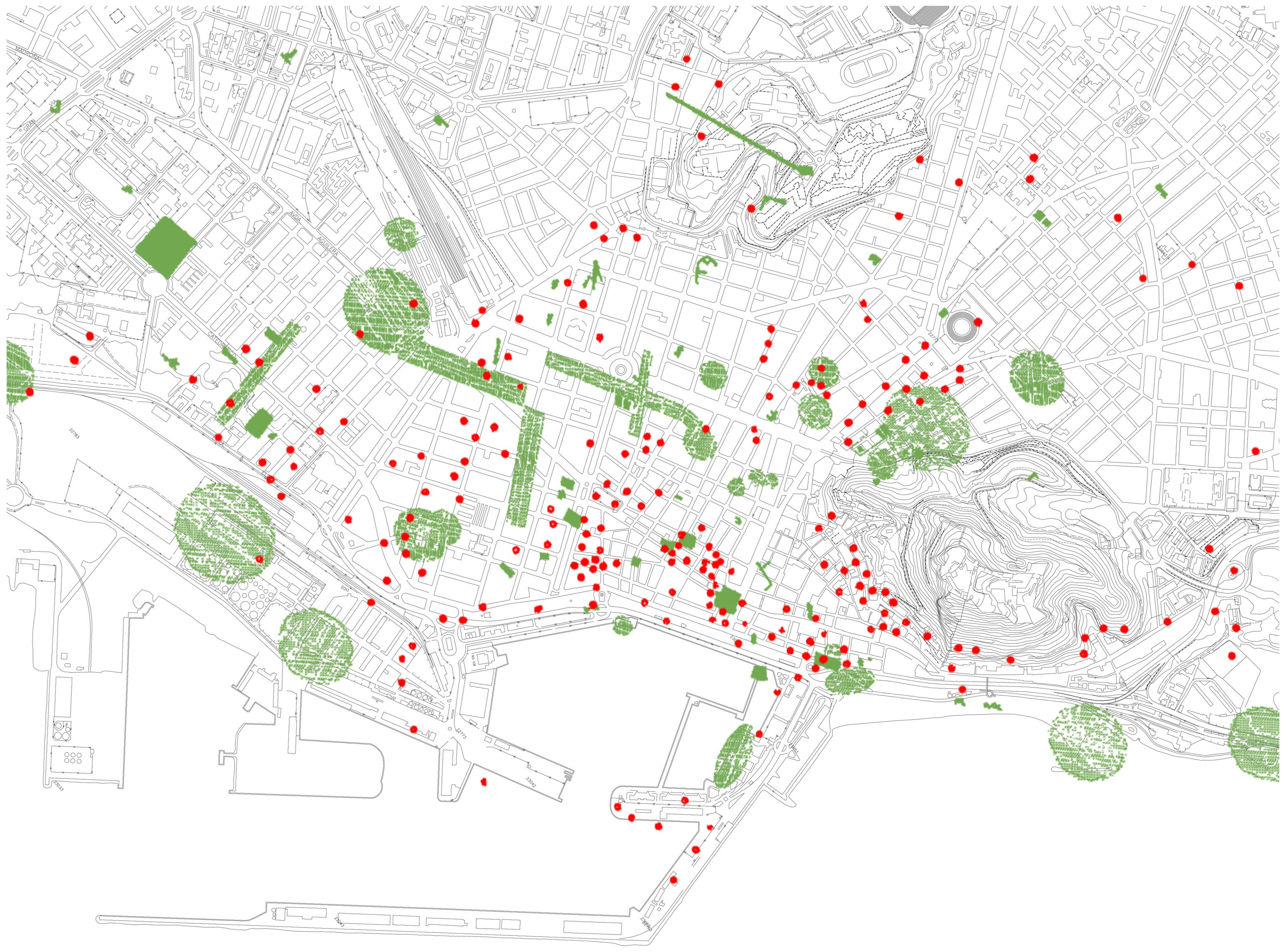
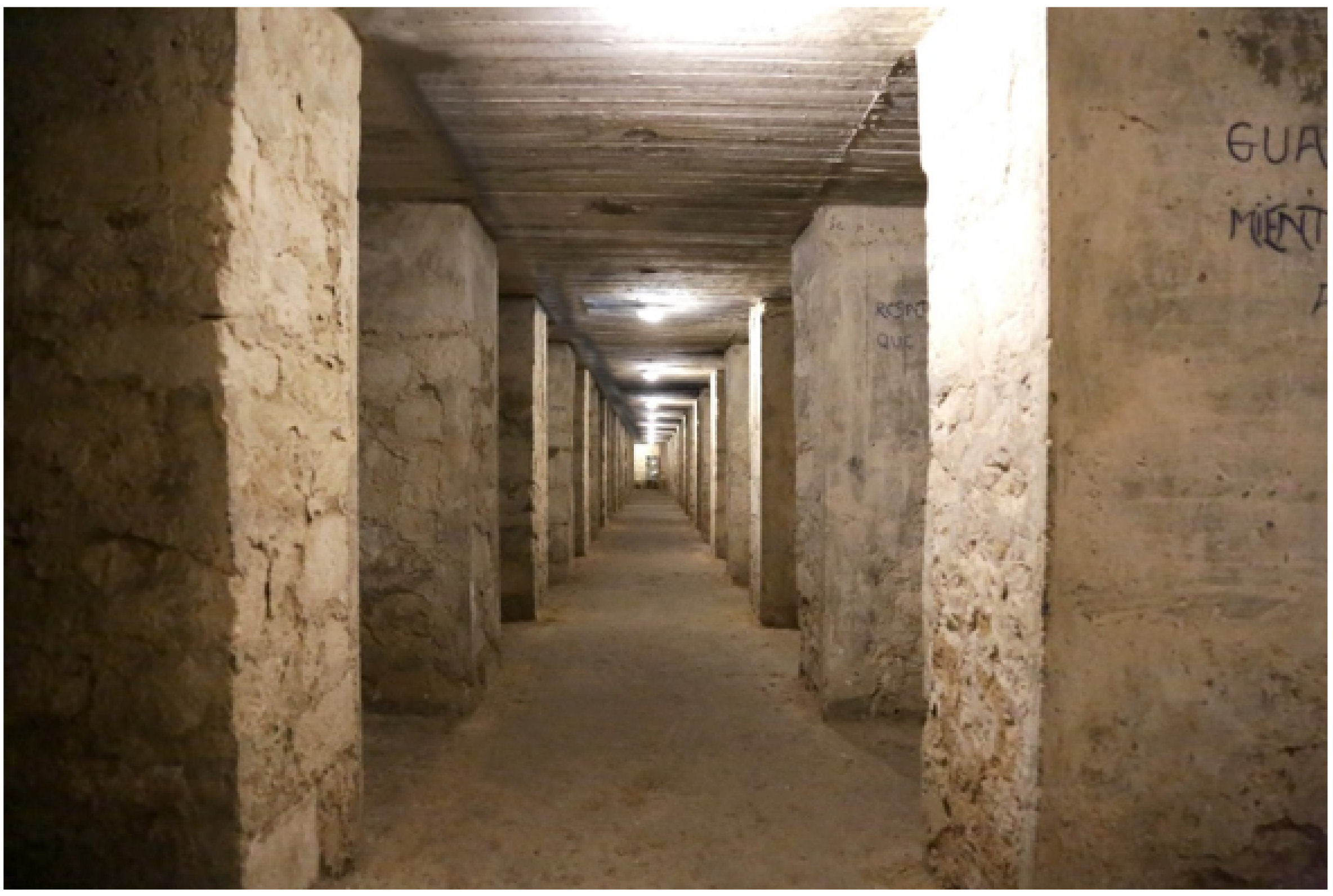



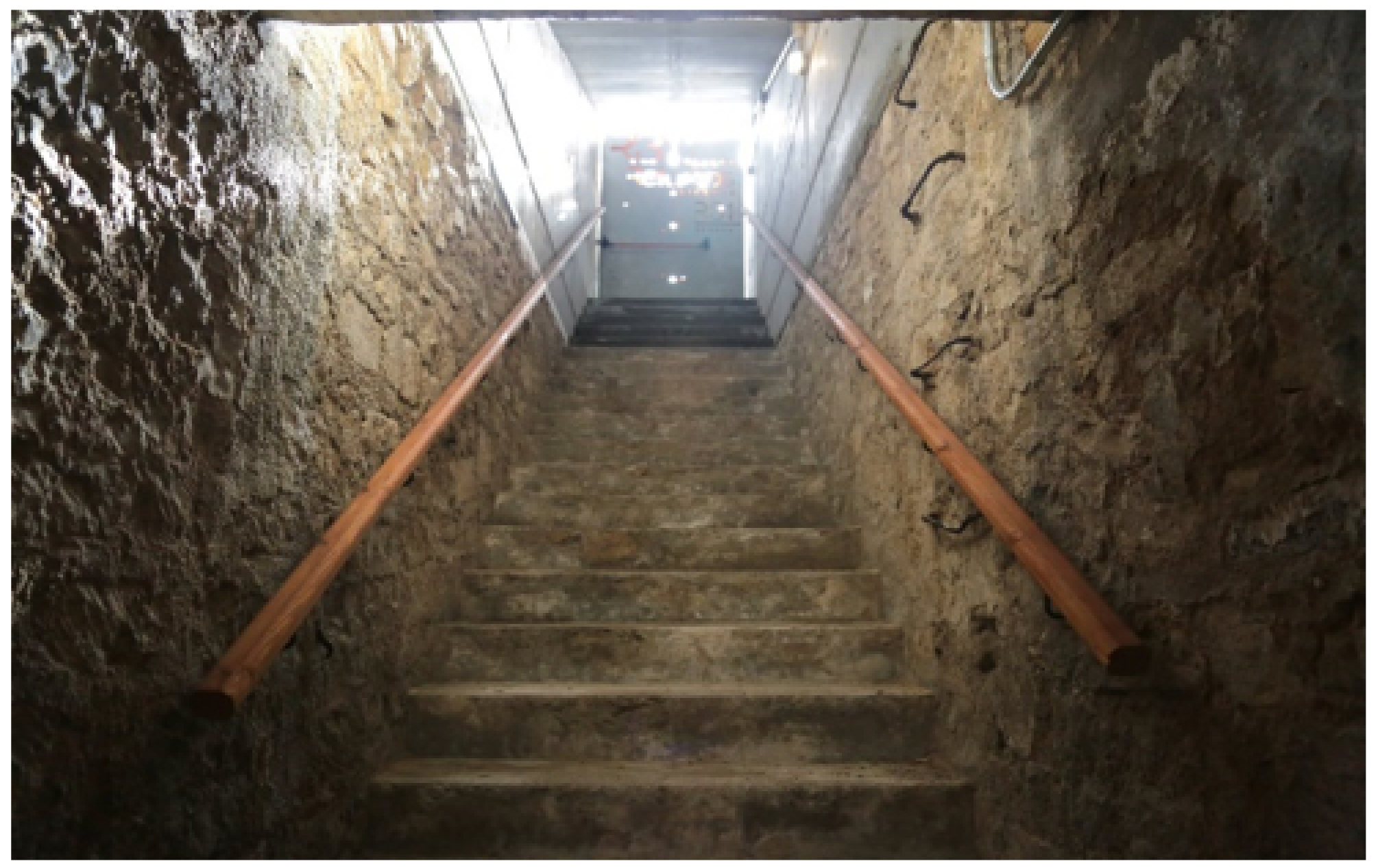
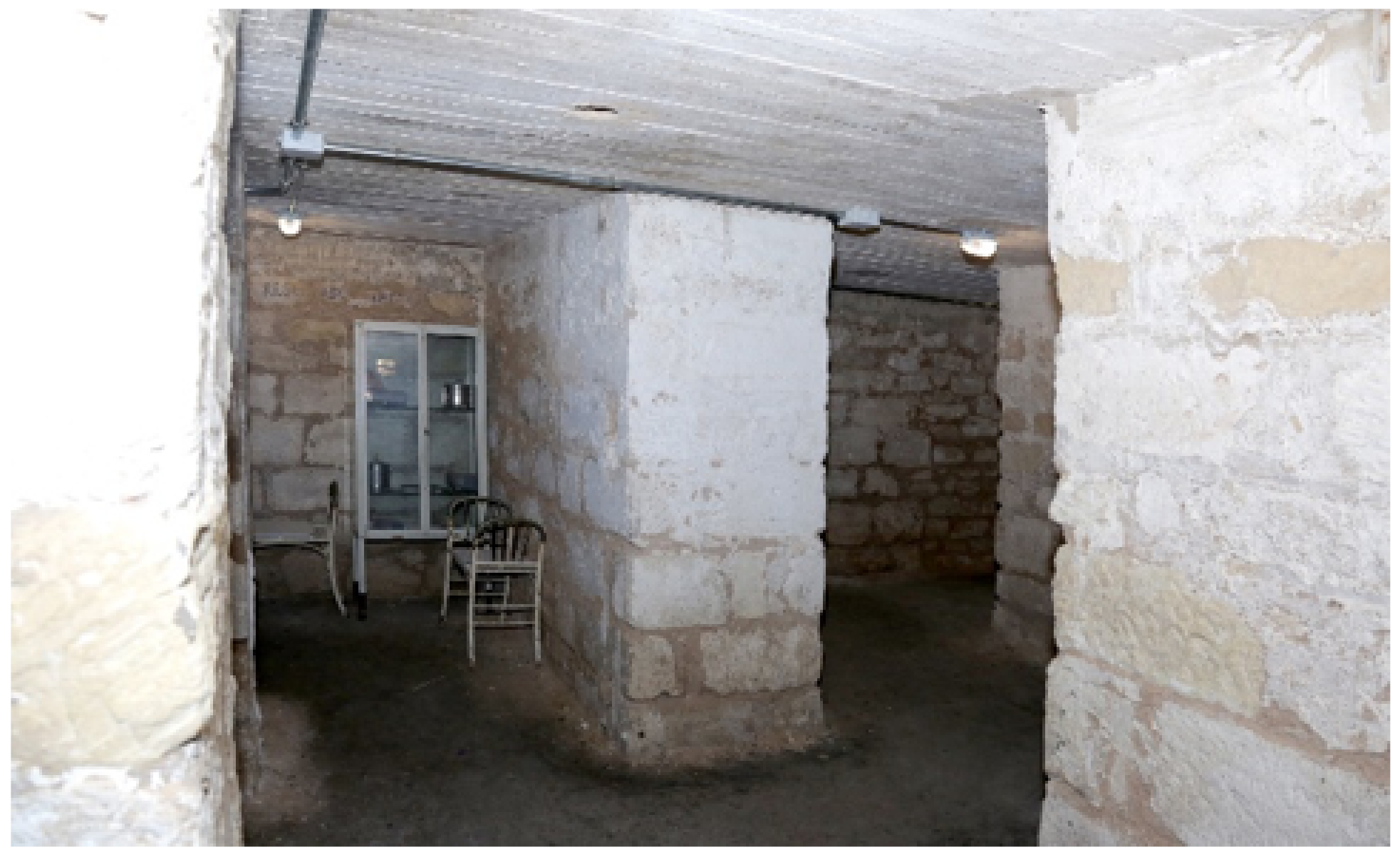

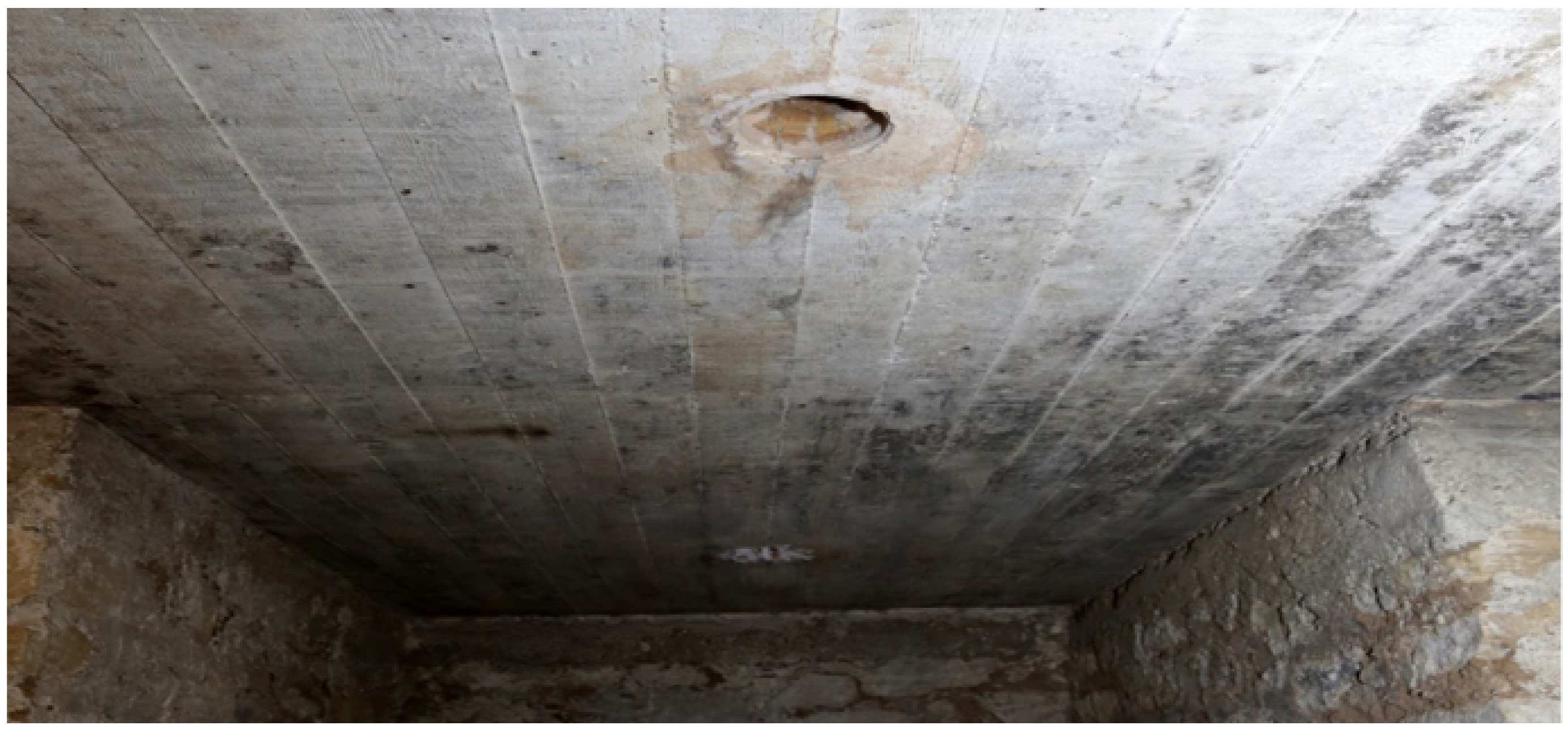
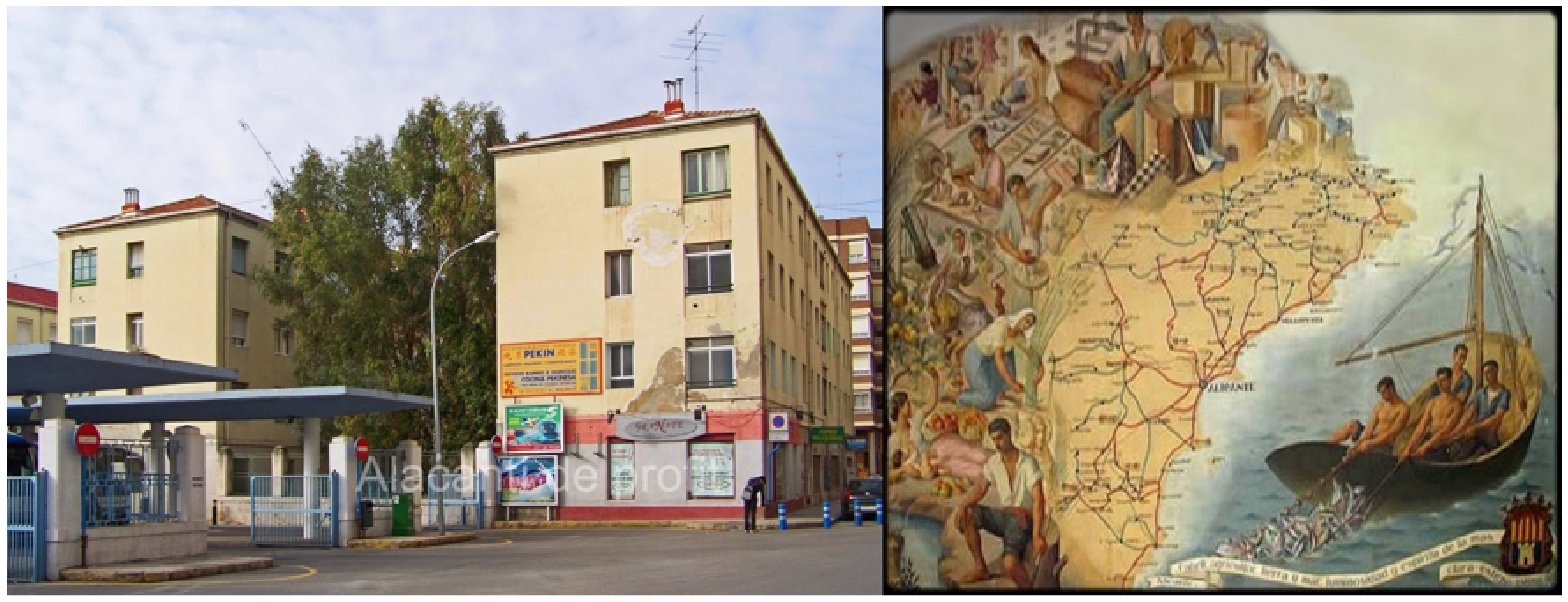


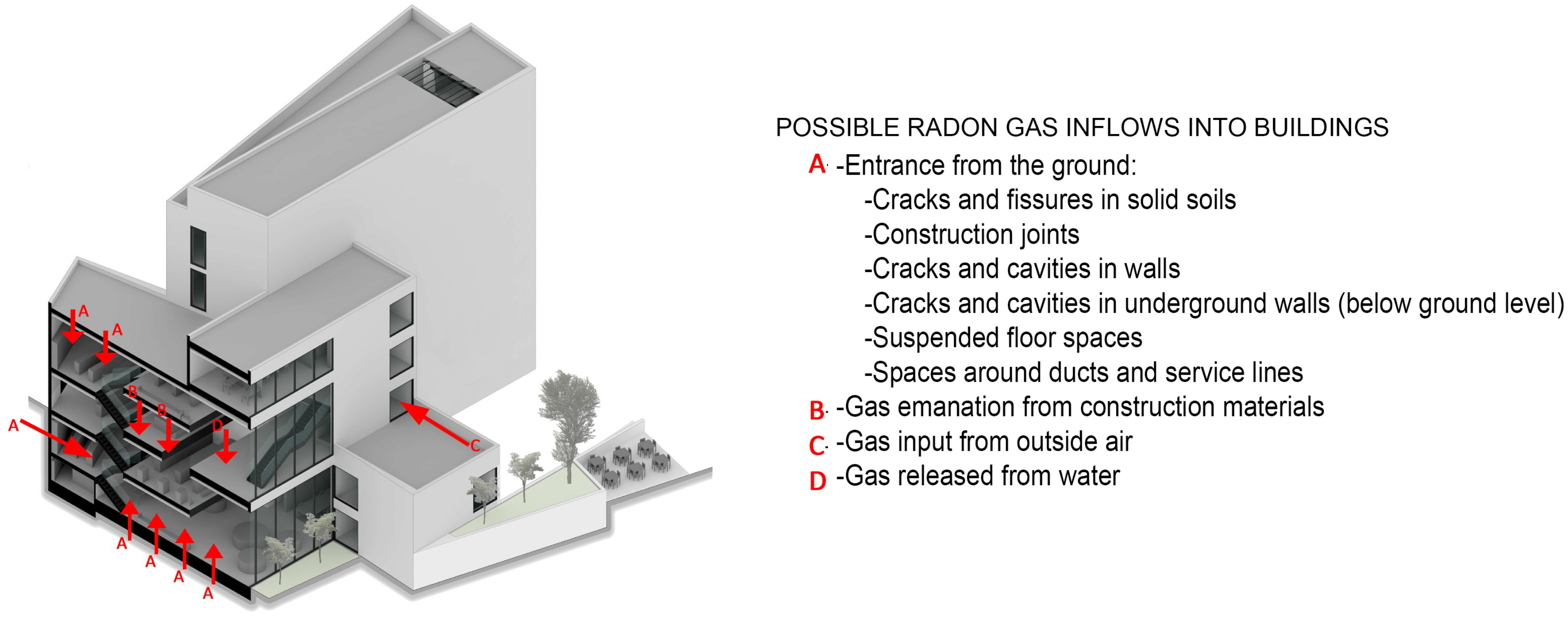
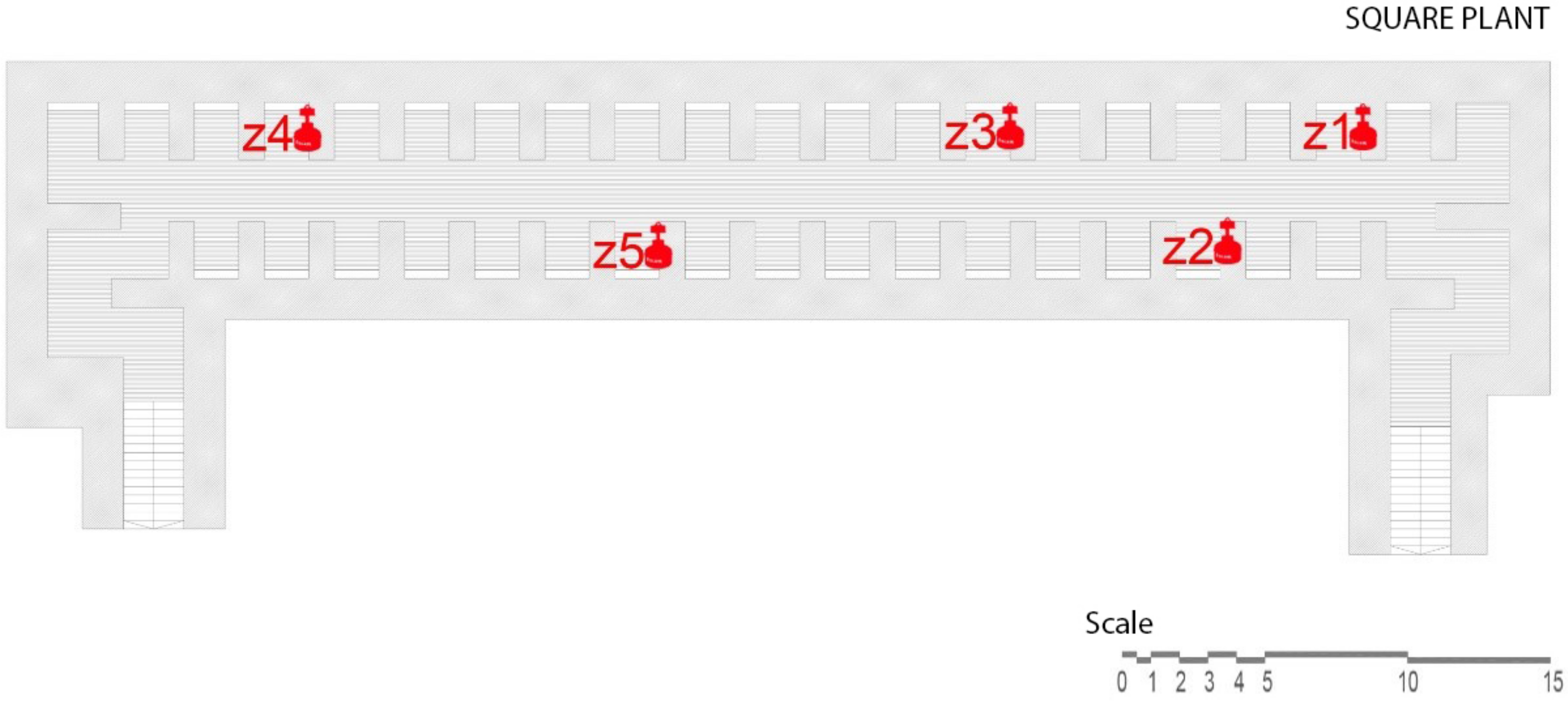
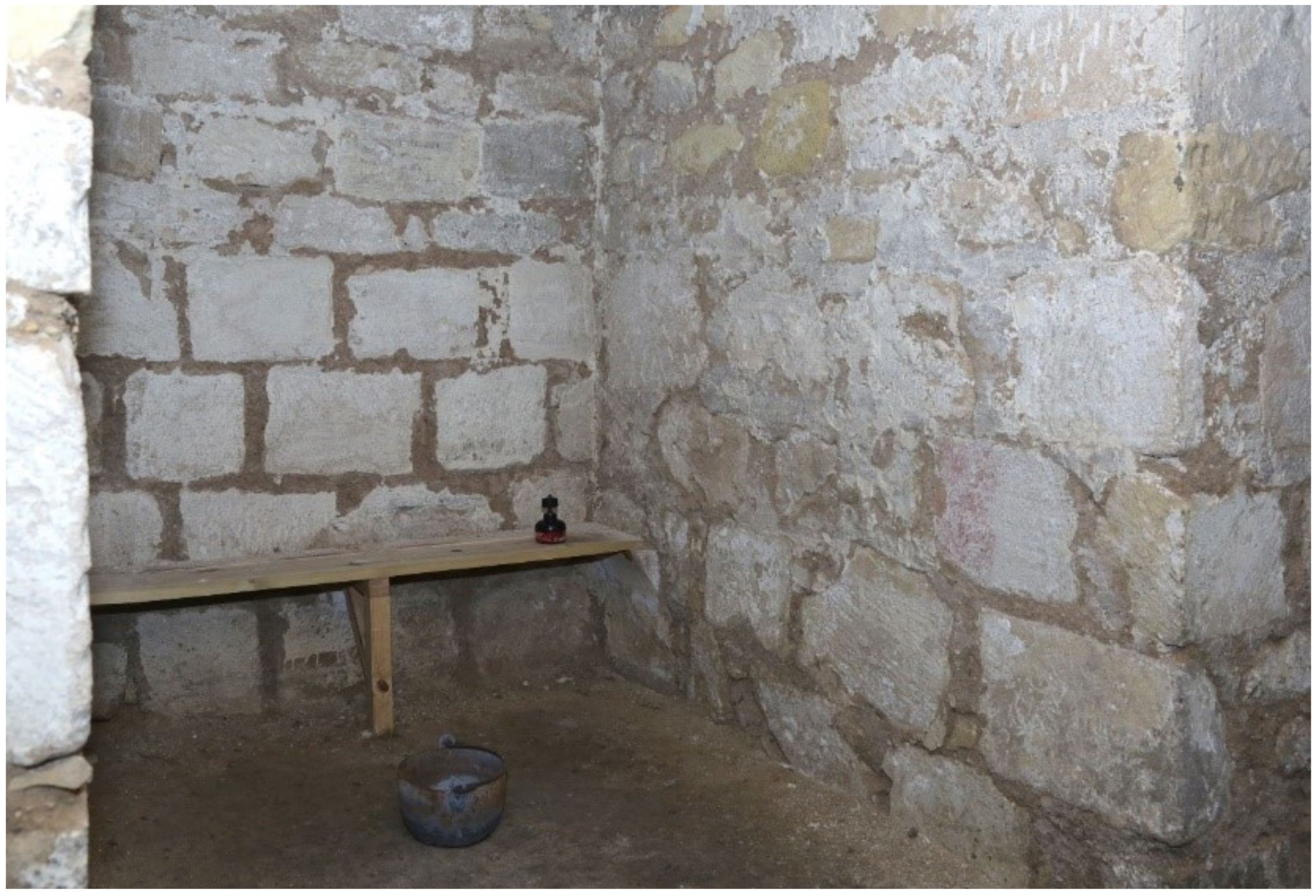
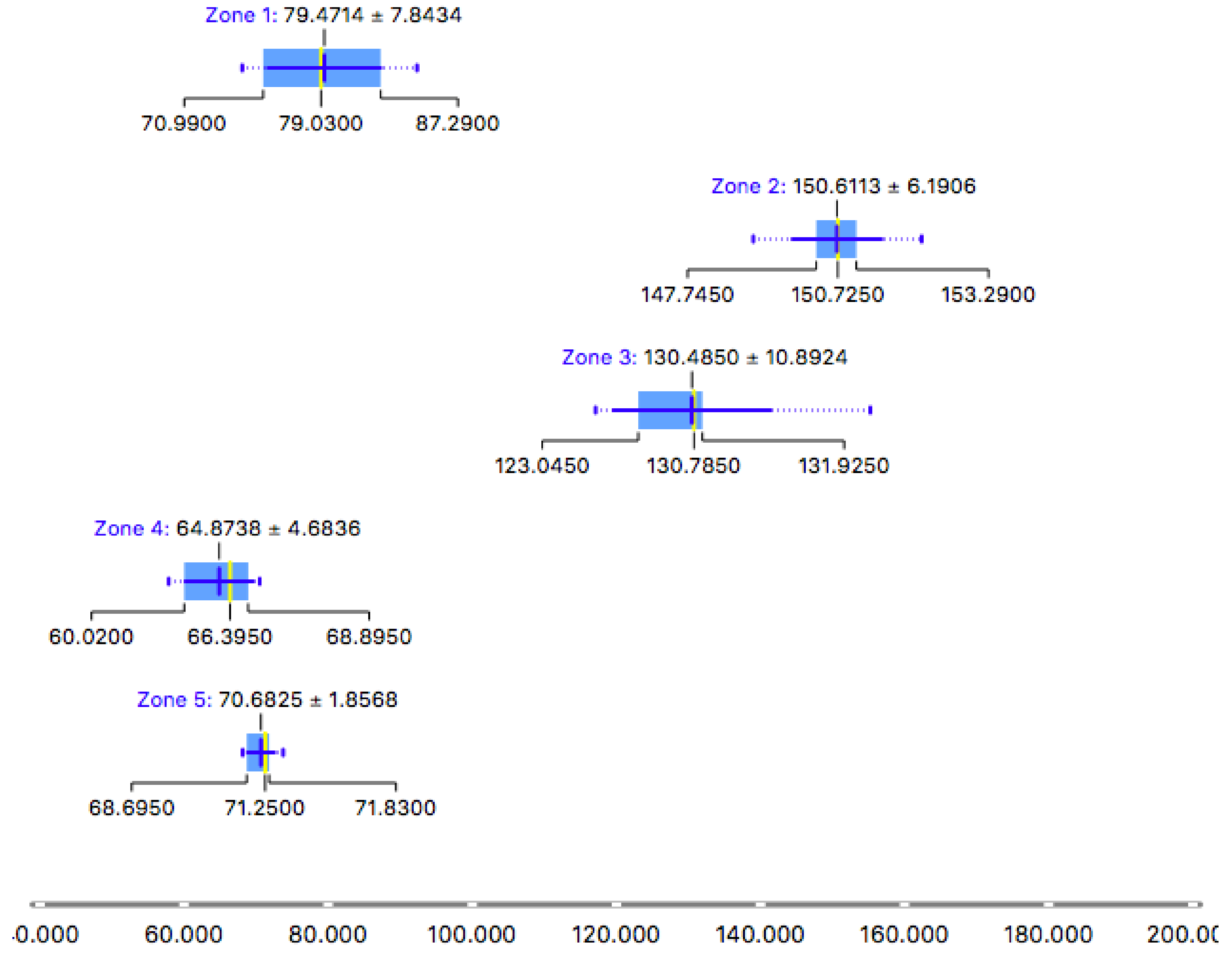
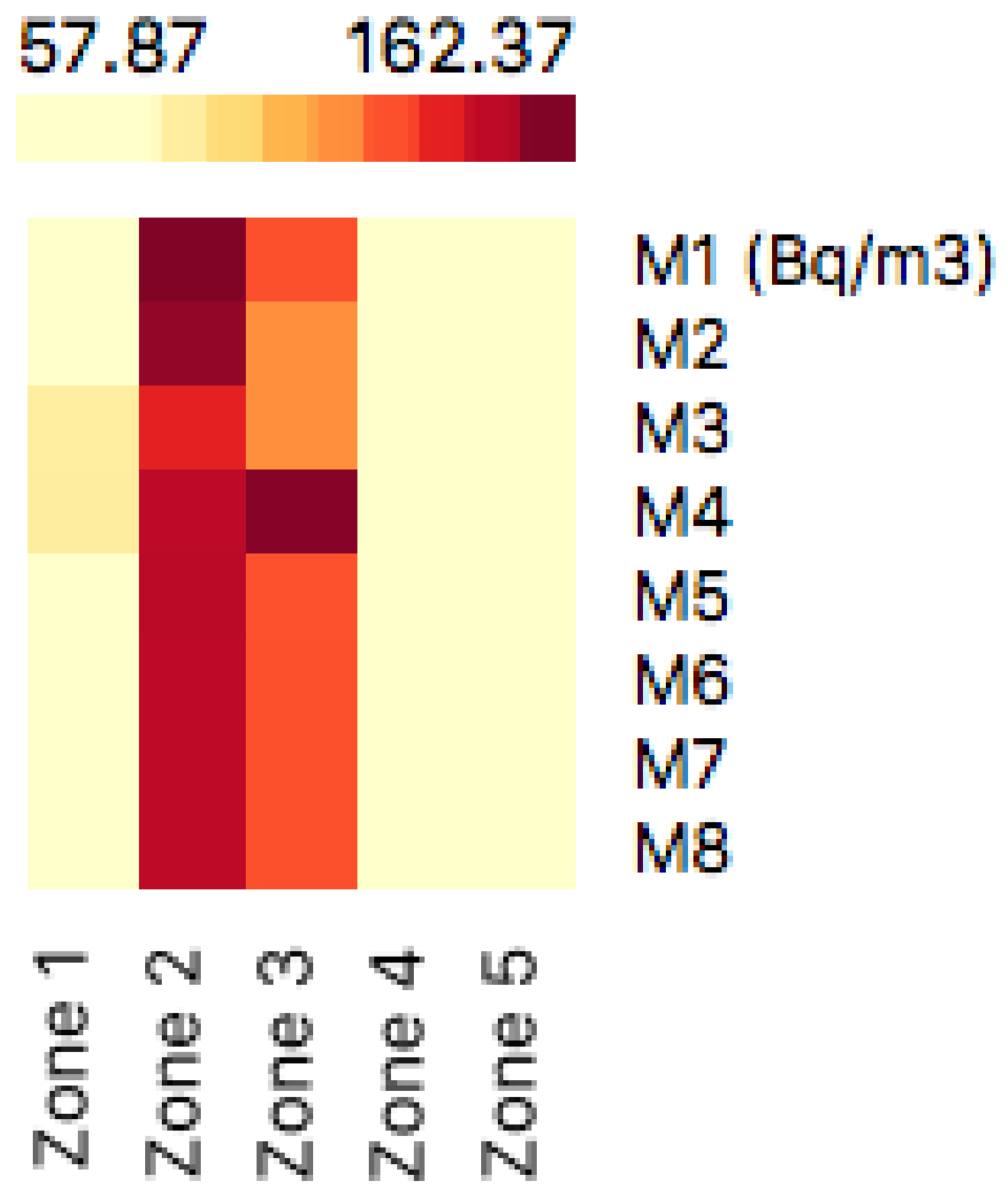
| Zone | Cubicle |
|---|---|
| Zone 1 | Cubicle 5 |
| Zone 2 | Cubicle 6 |
| Zone 3 | Cubicle 15 |
| Zone 4 | Cubicle 35 |
| Zone 5 | Cubicle 22 |
| Camera Type | Electrete Type |
|---|---|
| Short Camera | Short Electrete |
| Short Camera | Long Electrete |
| Long Camera | Short Electrete |
| Long Camera | Long Electrete |
| Zone | Samples | Mean Radon Concentration (Bq/m3) |
|---|---|---|
| Zone 1 | 8 | 79.47 |
| Zone 2 | 8 | 150.61 |
| Zone 3 | 8 | 130.48 |
| Zone 4 | 8 | 64.87 |
| Zone 5 | 8 | 70.68 |
© 2019 by the authors. Licensee MDPI, Basel, Switzerland. This article is an open access article distributed under the terms and conditions of the Creative Commons Attribution (CC BY) license (http://creativecommons.org/licenses/by/4.0/).
Share and Cite
Rizo Maestre, C.; Echarri Iribarren, V. The Importance of Checking Indoor Air Quality in Underground Historic Buildings Intended for Tourist Use. Sustainability 2019, 11, 689. https://doi.org/10.3390/su11030689
Rizo Maestre C, Echarri Iribarren V. The Importance of Checking Indoor Air Quality in Underground Historic Buildings Intended for Tourist Use. Sustainability. 2019; 11(3):689. https://doi.org/10.3390/su11030689
Chicago/Turabian StyleRizo Maestre, Carlos, and Victor Echarri Iribarren. 2019. "The Importance of Checking Indoor Air Quality in Underground Historic Buildings Intended for Tourist Use" Sustainability 11, no. 3: 689. https://doi.org/10.3390/su11030689





